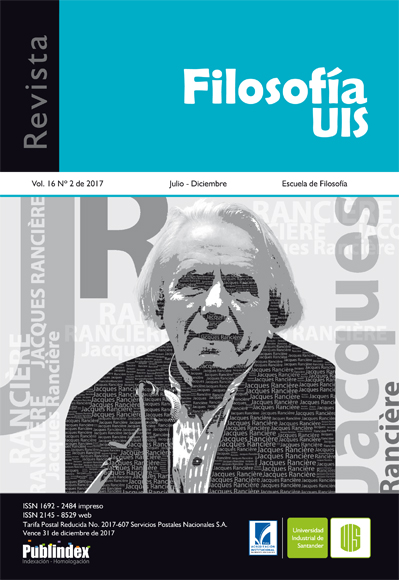Aesthetic disillusion: art and simulacrum on Jean Baudrillard
Published 2017-12-14
Keywords
- art,
- simulation,
- aesthetics,
- hyperreality,
- singularity
How to Cite
Copyright (c) 2017 Revista Filosofía UIS

This work is licensed under a Creative Commons Attribution 4.0 International License.
Abstract
This article aims to address the criticism of contemporary art and the human condition of advanced modernity presented by Jean Baudrillard identifying the notions that allow us to understand the banalization of the image and the decadence of aesthetic values in today’s world. The article has two moments; In the first, an approach is made to Baudrillard’s aesthetic thought and the arguments that support his main notions are synthesized; the second moment, theoretically deepens the notion of simulacrum and establishes the factors that affect the deterioration of the aesthetic experience. At the end of the reflection, a conclusion is made on the subject.
Downloads
References
Baudrillard, J. (1991). La guerra del Golfo no ha tenido lugar. Barcelona: Anagrama
Baudrillard, J. (1992). El intercambio simbólico y la muerte. Caracas: Monte Ávila Editores.
Baudrillard, J. (1997). Ilusión y desilusión estéticas. Caracas: Monte Ávila Editores.
Baudrillard, J. (2000). El crimen perfecto. Barcelona: Anagrama.
Baudrillard, J. (2002a). La ilusión vital. Buenos Aires: Siglo XXI.
Baudrillard, J. (2002b). Las estrategias fatales. Barcelona: Anagrama.
Baudrillard, J. (2005). Le complot de l’art: illusion et désillusion esthétiques. París: Sens & Tonka.
Baudrillard, J. (2007). El complot del arte. Ilusión y desilusión estéticas. Buenos Aires: Amorrortu.
Beuys, J. y Bodenmann-ritter, C. (1995). Joseph Beuys: cada hombre, un artista: conversaciones. Documenta (5), 1972.
Danto, A. (1999). Después del fin del arte. Barcelona: Paidós.
Derrida, J. (1989). De la economía restringida a la economía general. Un hegelianismo sin reservas. En La escritura y la diferencia. España: Anthropos.
Domínguez, J. et al. (2014). El arte y la fragilidad de la memoria. Medellín: Sílaba.
Hardt, M. y Negri, A. (2005). Imperio. Barcelona: Paidós.
Nietzsche, F. (1996). Humano, demasiado humano. Madrid: Akal.
Vaskes, I. (2008). La transestética de Baudrillard: simulacro y arte en la época de simulación total. Estudios de Filosofía, 38, 197-219.
Verdugo, L. (2010). Jean Baudrillard y la pérdida de ilusión estética. El desarrollo de un pensamiento apocalíptico. Revista Logos, (enero-junio) 17, 189-205.
Baudrillard, J. (2005) Simulacra and simulation. Recuperado de http://www.egs.edu/faculty/jean-baudrillard/articles/simulacra-and-simulations-xviii-on-nihilism/
